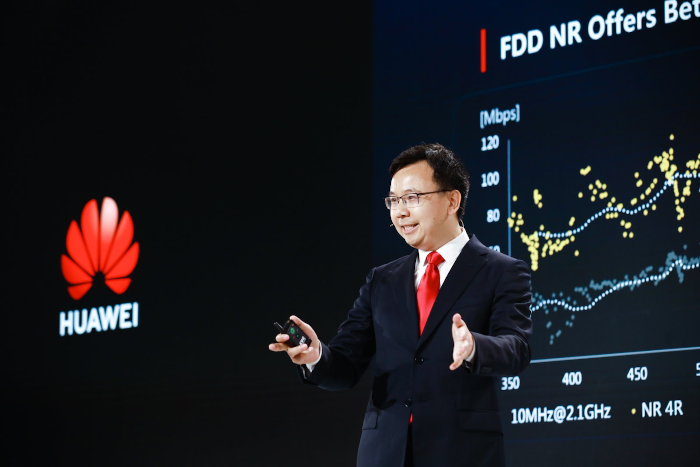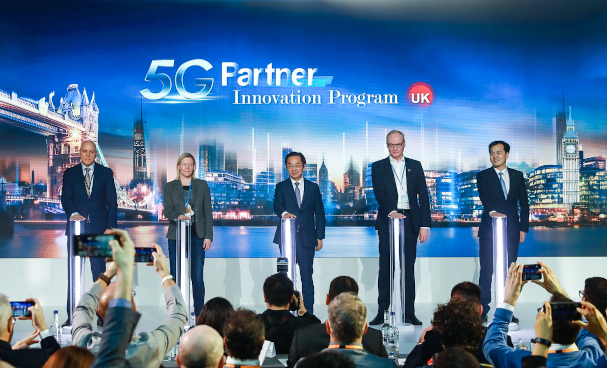
Huawei unveils new 5G plans in London
Huawei unveiled several new 5G products and solutions at an event in London last week as part of the company’s commitment to enhancing its 5G network.
Significant emphasis was placed on Huawei’s simplified radio access network (RAN) end-to-end 5G solutions. As part of its simplified RAN, Huawei unveiled a third-generation Massive MIMO, the Blade AAU and a 400 MHz ultra-wideband AAU. Huawei’s 5G AAU uses proprietary Huawei chips that it claims can lower power consumption by up to 15%. The Chinese telecoms company said the new kit could transform a network into smart, SLA-committable IP networks, with a slicing precision at 1Gbps.
Delivering a keynote titled ‘5G, Bring New Value’, executive director of Huawei’s board and president of BG, Ryan Ding launched several solutions designed “to unlock the potential of the future.” Ding announced the release of the Blade AAU and a 5G based station which the company claims is the highest performing in the industry. The Blade AAU can work under all sub-6 GHz frequency bands and supports 2G, 3G, 4G, and 5G networks. Operators can use it to replace 3G/4G antennas to facilitate 5G deployment with single antenna space. In addition, the integrated design greatly simplifies site installation, which in turn improves 5G construction efficiency and accelerates overall deployment. Designed for limited space environments, the Blade AAU reduces total cost of ownership by 30% than existing solutions. This is the first industrial 5G module for vertical application.
Third generation Massive MIMO
Huawei also showcased the industry’s lightest Massive MIMO AAU to date. Weighing 25kg, which Huawei claims is 30% less than industry average, the solution can improve network construction efficiency. “In 2019, Huawei helped LG U+ in South Korea, EE in the UK, and Sunrise in Switzerland to deploy 5G commercial networks,” said Yang Chaobin, president of Huawei 5G product line. “In the third-party network performance tests conducted by RootMetrics and Connect, Huawei helped its operators rank number one in user experience, with an average downlink rate of one and a half, to two times higher than that of competitors’ networks, which further demonstrates Huawei’s superior Massive MIMO performance in actual commercial use.”

B2C and B2B
While 4G allows individuals to share videos and voices, 5G’s ultra-high bandwidth will enable people to enjoy immersive augmented reality (AR) and virtual reality (VR) experiences. Ding said that as 5G enhanced mobile broadband (eMBB) matures, high-definition video services will drive growth of 5G B2C services.
Huawei is exploring B2B applications in order to drive 5G application in numerous industries. At the launch event, Ding showed the audience Huawei’s 5G module embedded live broadcast backpack, designed to make live broadcasting easier.
In the 4G era, Ding said that virtually all operators provided the same network experience. In the 5G era, however, he said operators can provide differentiated experiences and charge users based on more metrics, including data volume, latency, bandwidth, and number of devices connected.
E2E network slicing solution
To further industrial digitisation, Huawei launched an end-to-end slicing solution that spans RAN, core network, transport network and terminals. An industry-first, Huawei said the solution will enable telecom operators and industry customers to diversify services on demand and provide high bandwidth and low latency all while reducing costs and improving efficiency.
5G Partner Innovation Programme
Huawei has worked on 5G projects in various domains including new media, campus, healthcare and education. As part of its 5G Partner Innovation Program, it will invest $20 million in innovative 5G applications over the next five years. Programme partners will join forces to accelerate the adoption and commercialisation of 5G.

HiCampus solution
Huawei also announced the global release of its HiCampus solution. In harnessing Huawei’s 5G, optical transmission, and AI technologies enterprises can access wireless, optical, and intelligent network services across campuses. The solution was built to help enterprises build next-generation networks.
The 5G-powered AirEngine Wi-Fi 6 achieves 10 Gb/s, 10ms latency and should achieve high-quality, fully wireless access across campuses. According to Huawei, AirEngine Wi-Fi 6 guarantees continuous networking at scale, which enables users to benefit from an unprecedented, always-on 100Mb/s Wi-Fi network at any time and from anywhere within a campus.
Qiu Heng, president of global marketing, Huawei Enterprise Business Group said: “HiCampus demonstrates Huawei’s leading advantages in 5G, optical transmission and AI technologies. The solution enables users to benefit from an always-on 100Mbps Wi-Fi network anytime, anywhere within a campus, and it lowers overall network power consumption by 30% while improving collaboration efficiency by 30%. This will greatly accelerate the digital transformation of enterprise campuses.”
Consistent 5G experience
At the event, Huawei showcased its broad product portfolio which it said provides a consistent user experience. Its three-layer networking architecture includes macro base stations for basic coverage, Easy Marco deployed at pole sites for supplementary coverage, and LampSite for indoor digital systems.
Ultra-broadband solution
Huawei also launched the industry’s only full series of ultra-broadband solutions, which support a maximum bandwidth of 400 MHz. According to the company continuous large-bandwidth TDD spectrum is the optimum choice for achieving an ultimate 5G experience in the 5G era. The ultra-broadband solution simplifies network deployment and saves modules.
Monetisation for 5G SA network
The industry’s first 5G SA network-based monetisation solution was also launched at the event. “To achieve monetization of all levels, a unified billing system is required for consumers of all ends such as individuals, households and enterprises,” said Rockred Zhang, president of Huawei software business unit. “An agile and open system is also necessary to enable partners to expand their business fast enough.”
Its Convergent Billing System (CBS) R20 has already been deployed over the stc Kuwait 5G SA’s network. Huawei claims the CBS R20, which will support a range of combinations involving 1,000 billing factors and 100 common 5G service combos, could lead the industry in terms of monetisation, standards setting and systems architecture. The system supports 5G NSA and 5G SA network.

“Every new generation of mobile communications technologies is developed to offer more applications and a better experience. 5G is no exception,” said Chaobin. “5G coverage must be good enough to provide excellent experience, and 5G experience must be better than any of the previous generations. Huawei’s products and solutions are committed to carrying forward this mission. 2020 will be a key year for 5G to be put into commercial use on a larger scale.
Chaobin continued: “No one can whistle a symphony; it takes an orchestra to play it. We hope to work with global partners to continuously carry out technology and application innovations, which utilise 5G as the connection platform, together with AI and Cloud technologies, to jointly build a healthy, viable, and sustainable digital ecosystem.”
TechCentral Reporters







Subscribers 0
Fans 0
Followers 0
Followers